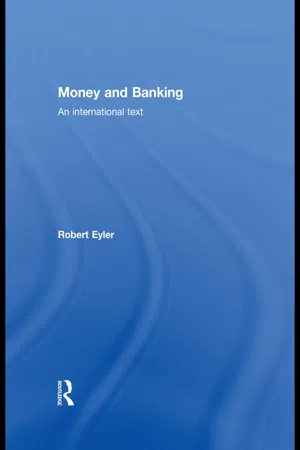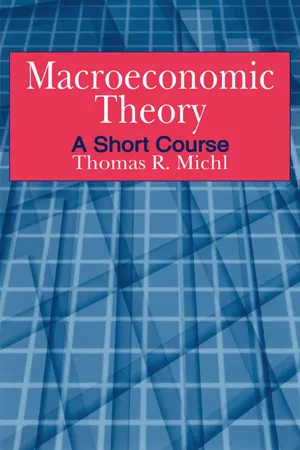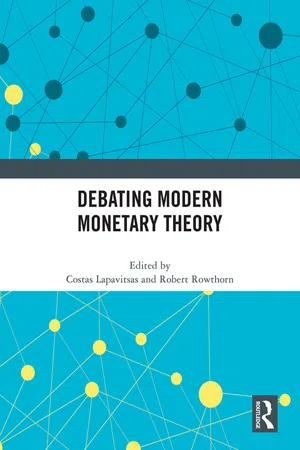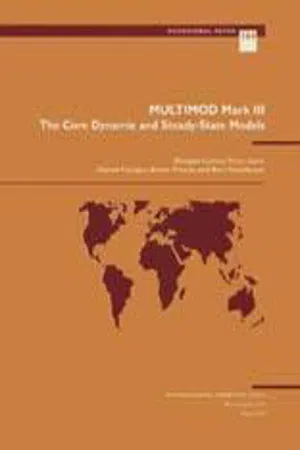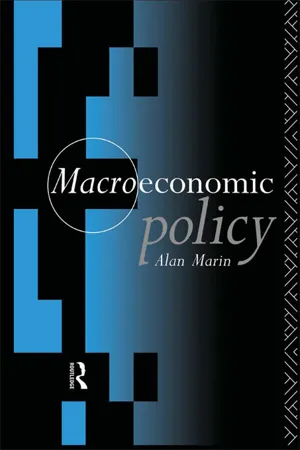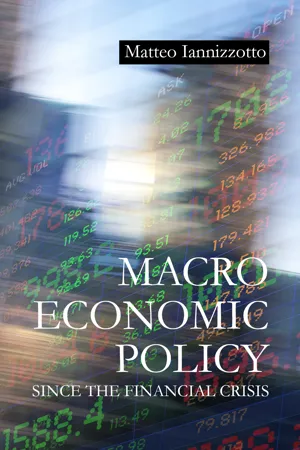Economics
Modern Phillips Curve
The modern Phillips Curve is a concept in economics that describes the inverse relationship between inflation and unemployment. It suggests that when unemployment is low, inflation tends to rise, and vice versa. Unlike the original Phillips Curve, the modern version acknowledges that this relationship can shift over time due to various factors such as expectations, supply shocks, and changes in economic structure.
Written by Perlego with AI-assistance
Related key terms
Related key terms
1 of 4
Related key terms
1 of 3
10 Key excerpts on "Modern Phillips Curve"
- eBook - ePub
Defensive Expectations
Reinventing the Phillips Curve as a Policy Mix
- Liviu Voinea(Author)
- 2020(Publication Date)
- Palgrave Macmillan(Publisher)
© The Author(s), under exclusive license to Springer Nature Switzerland AG 2021 L. Voinea Defensive Expectations https://doi.org/10.1007/978-3-030-55045-5_1Begin Abstract1. The Imperative of Adjusting the Phillips Curve
End AbstractLiviu Voinea1(1) OEDNE, International Monetary Fund, Washington, DC, USAThe Phillips Curve is a relationship between inflation and a measure of economic slack reflecting the intensity of resource utilization. Initially, as proposed by Phillips himself in 1958 and by the American economist Irving Fisher three decades earlier, it described the relationship between inflation and unemployment. To put it in Phillips’ own words: “the rate of change of money wage rates can be explained by the level of unemployment and the rate of change of unemployment.”1 Later on, two Nobel laureates, the father of monetarism Milton Friedman and Edmund Phelps, added the inflationary expectations and the natural rate of unemployment, fundamentally altering Phillips’ simple equation, which had its roots in the Keynesian economics (Keynes 1936 ). Inflation was a function of its own persistence, of its expectations and of a measure of labor market slack—the unemployment gap (the deviation of unemployment from its natural rate). At the turn of the century, the New Keynesian Phillips Curve (NKPC) was developed—replacing inflation persistence by inflation expectations and the unemployment gap by the output gap, a more comprehensive measure of slack for the whole economy (one of the most prominent proponents of this change was the Spanish economist Jordi Gali).Different versions of the Phillips Curve have represented a standard feature in the general equilibrium models of central banks around the world. Therefore, the Phillips Curve has been critically important for the monetary policy for more than half a century. It started as a “menu of choice” as it was described by two other Nobel laureates—Paul Samuelson and Robert Solow—the neo-Keynesian founders of modern macroeconomics. Then it offered the breakthrough the neo-classical economists needed to build their theory and it provided the grounds for Lucas’ (another Nobel laureate) critique2 - eBook - ePub
Money and Banking
An International Text
- Robert Eyler(Author)
- 2009(Publication Date)
- Routledge(Publisher)
Figure 10.2 shows the short-run version of this curve; Equation 10.2 shows the Phillips Curve in a mathematical form. The downward slope represents the inverse relationship and the opportunity cost of pursuing lower inflation or unemployment as an explicit goal of monetary policy.(10.2) Figure 10.2 The short-run Phillips Curve.Equation 10.2 shows the relationship between unemployment and expected inflation, where the difference between the current unemployment rate and the natural rate of unemployment determines the amount of expected inflation, including a positive trend and error.6 The parameter represents the sensitivity of expected inflation to a marginal difference in current unemployment from the natural rate; > 0. The larger the value of , the more sensitive the relationship is between unemployment and inflation (steeper Phillips Curve); the less positive ’s value is, the flatter the Phillips Curve and the less sensitive inflation expectations are to changes in unemployment.The transmission mechanism discussed earlier helps understand how sensitive expectations can be. Suppose expansionary monetary policy took place. The relationship between the change in unemployment and the subsequent inflation would depend on how fast both firms and workers reacted to the new policy. The faster both sides react to new inflation expectations, the steeper the Phillips Curve should be. Notice there is no mention of unemployment expectations, only prices. This idea connects back to aggregate demand: when monetary policy changes, aggregate demand changes and creates incentives for more production or real GDP. The fact that more employment (less unemployment) is a result of monetary expansion is not debated, i.e. the aggregate supply curve is either flat or upward-sloping when the economy is not in full employment. Whether it is flat or upward-sloping depends on how workers and firms react to their price expectations. - eBook - ePub
Inflation Dynamic
Global Positive Economic Analysis
- Weshah Razzak(Author)
- 2023(Publication Date)
- Routledge(Publisher)
8 The Phillips Curve, Anticipated Inflation, and OutputDOI: 10.4324/9781003382218-8Abstract
We discuss the evolution of and the theoretical issues surrounding the Phillips curve, which was originally (Phillips, 1958 ) a negative empirical relationship between the unemployment rate and the inflation rate. It has been the dominant theory of inflation in central banks in developed countries. Policymakers and politicians seem to like the idea that they could influence the economy by exploiting this relationship, that is, in order to create more employment, they inflate the economy. By late 1960s and through the 1970s, more theoretical analyses showed that such exploitation is fruitless because unanticipated aggregate demand shocks, that is, surprises, ignored by Phillips, is the only significant determinant of real output. Anticipated aggregate demand shocks, on the other hand, are ineffective in stimulating the economy. Every time the monetary authority attempts to stimulate demand, it increases real output (reduces unemployment) in the short run, then inflation expectations shift up the Phillips curve, and real output (unemployment) returns to their long-run equilibrium before the policy change. If the monetary authority continues to stimulate the economy, the Phillips curve keeps shifting up via expectations effects, and, in the long-run, the economy ends up with more inflation and no change in real output or unemployment; hence the Phillips curve is vertical in the long run, and no trade-off between inflation and output (unemployment) exists. Our Sample Generalized Variance tests indicate that the New Keynesian specification, change in inflation–output gap, is unstable in most of the 42 countries in our sample.Monetary theories of inflation are contentious. There are stark differences of opinions between economists about the determinants of inflation. So far, we have only analyzed the QTM, where in the long run, inflation is caused by, or is highly correlated with, the growth rate of the quantity of money per unit of real output. Remember that we define inflation as a continuing increase in the price level, and the difference between the short run on one hand and the long run - eBook - ePub
Macroeconomic Theory: A Short Course
A Short Course
- Thomas R. Michl(Author)
- 2015(Publication Date)
- Routledge(Publisher)
10.5: Starting from a long-run equilibrium (A), an increase in the rate of growth of the money supply from 5 per cent per year to 6 per cent per year causes the system to move along its Phillips curve in the short run (B). Because inflation expectations chase after actual inflation, next year’s equilibrium lies on the new Phillips curve (C). Ultimately, the system will achieve the new long-run equilibrium (D). The arrow shows the path taken when the model has a stable focus, which involves overshooting the equilibrium.In its first period, the policy moves the economy along its existing Phillips curve. Since workers follow adaptive expectations, they believe that the inflation rate will remain at its original level (the old long-run equilibrium inflation rate).In its second period, the policy works through both dynamic processes we described above. The Phillips curve shifts upward because the expected rate of inflation, which positions the Phillips curve, chases after the actual rate of inflation, which rose in the first year. The unemployment rate in Figure 10.5 has continued to decline, because the inflation rate is still below the new growth rate of the money supply set by the central bank.At some point in time, the economy will reach a turning point where the unemployment rate will cease dropping and begin to rise. This will occur when the inflation rate rises above the growth rate of the money supply. The Phillips curve will then be shifting upward and the unemployment rate will be rising, so that inflation and unemployment increase simultaneously, a phenomenon known as stagflation. The ability of the expectations-augmented Phillips curve to explain the stagflation of the 1970s played a major role in its acceptance by the economics profession.Another turning point is reached when the unemployment rate rises above the natural rate of unemployment. As we have seen, in this configuration the Phillips curve shifts downward over time because inflation expectations overestimate inflation, and are being revised downward. The economy experiences falling inflation and rising unemployment until the next turning point is reached. - eBook - ePub
- Costas Lapavitsas, Robert Rowthorn, Costas Lapavitsas, Robert Rowthorn(Authors)
- 2022(Publication Date)
- Routledge(Publisher)
The latter introduced the Expectations-Augmented Phillips Curve (EAPC), which spearheaded the resurgence of pre-Keynesian macroeconomic thinking in the form of Monetarism. The natural rate of unemployment (NRU) concept became central to the idea that the tradeoff between inflation and unemployment, captured in the Phillips curve, was in fact a tradeoff between unemployment and unexpected inflation. Once expectations are realized as workers gain more information, the tradeoff vanishes. At this point there is only one unemployment rate consistent with stable inflation—the NRU, later the Non-Accelerating Inflation Rate of Unemployment (NAIRU) (Modigliani and Papademos 1975). The expectations-augmented Phillips curve led to the New Classical representation incorporating rational expectations, which cast price misperceptions as random variables and concludes that any observed tradeoffs arise because of random shocks, which are beyond the scope of policy (for example, Lucas 1972 ; Sargent, Fand, and Goldfeld 1973). It is invalid to interpret this sequence of ideas as a consistent development of a paradigm with increasing theoretical and empirical content. The 1958 version of the Phillips curve and its subsequent Keynesian variants were based on a disequilibrium notion where prices and wages adjust to some labor market imbalance between supply and demand. There is no presumption that full employment is inevitable or a natural tendency of a capitalist monetary economy. In contradistinction, the EAPC and later developments gained motivation from Fisher (1926) who worked within a market-clearing framework. These developments represent a major break from Phillips (1958) because the causality is reversed. Unemployment is considered to be the voluntary outcome of optimizing choices by individuals between work (bad) and leisure (good). Full employment is assumed to prevail (unemployment at the natural rate) unless there are errors in interpreting price signals - Hamid Faruqee, Douglas Laxton, Bart Turtelboom, Peter Isard, and Eswar Prasad(Authors)
- 1998(Publication Date)
- INTERNATIONAL MONETARY FUND(Publisher)
If monetary policy becomes highly inflationary, for example, the proportion of myopic agents would decline, the speed of learning would increase, and the prevalence and average duration of multiperiod nominal contracts would decline. In practice, however, almost all macro models describe the supply side of the economy with a Phillips curve, given the strength of the empirical correlations in historical data and the lack of more attractive alternatives. This is also the case in MULTIMOD, which treats the Phillips curve as a structural relationship. That being said, we regard it as incumbent on model users to avoid subjecting their models to policy experiments for which the underlying assumptions about inflation expectations would break down. When specifying a Phillips curve relationship in the form of equations (6) and (7), it is important to place a positive weight on the model-consistent expectation (that is, Φ > 0). Otherwise, the model is inconsistent with the LR-NRH, since with Φ = 0 it would always be possible for the monetary authorities to fool people systematically and raise the level of output in the long run by continuously increasing the rate of growth of the money supply. 45 The condition that Φ > 0 implies that the long-run Phillips curve is vertical and that real variables, such as the unemployment rate, are tied down by real factors, such as tastes and technology, and are to a first approximation independent of both the level of the money supply (the condition of monetary neutrality) and the rate of growth of the money supply (monetary superneutrality)- eBook - ePub
- Alan Marin(Author)
- 2005(Publication Date)
- Routledge(Publisher)
It is important to note that, as stressed in the original Lipsey approach, we do not have direct measurements of the demand and supply of labour schedules and therefore cannot directly observe the level of unemployment at which the demand and supply of labour are equal. Hence estimates of the natural rate are usually obtained indirectly by econometrically estimating an expectations augmented Phillips Curve and then using the estimated curve to see at which level of unemployment inflation would be steady. If it is found that the natural rate varies, it is always possible to provide some justification, but the feeling remains amongst some critics that the procedure is ad hoc. 43 Even according to what is probably the majority view, which accepts the empirical validity of the expectations augmented Phillips Curve, the policy implications are not necessarily as straightforward as suggested by the above 1976 quote by the UK Prime Minister. As put by those who feel that the Vertical Phillips Curve’ rules out any attempt to reduce unemployment by macroeconomic policy (as opposed to microeconomic policies to shift the natural rate), it would seem that any such attempt will lead simply to higher inflation without any benefit to employment and output. However, the speed with which inflation rises depends on two factors: (i) the slope of the short-run Phillips Curve; (ii) the speed with which expectations of inflation alter. If the short-run Phillips Curve is relatively flat, then an expansionary monetary/fiscal policy will have relatively little immediate impact on the rate of wage increases. If expectations of future inflation adapt only very sluggishly to actual inflation, then the short-run Phillips Curve will not quickly shift up very far. Thus the mere existence of an expectations augmented Phillips Curve does not in itself mean that runaway inflation will soon result from any attempt to reduce inflation - eBook - ePub
- Matteo Iannizzotto(Author)
- 2023(Publication Date)
- Agenda Publishing(Publisher)
3 Behind the three equations II: inflation and the Phillips curve3.1 Inflation and the Phillips curveIt must be remembered that the Phillips curve is first and foremost an empirical relationship that was originally meant to relate wage inflation and unemployment (Phillips 1958 ). Ever since it has been in search of a theoretical justification that has come in different guises and sometimes these have also been radically different. In the context of the three-equations model (or the DSGE) it is meant to represent the behaviour of inflation relative to some measure of the output gap. Stripped of all deeper theoretical foundations, that is its bare purpose. Inevitably, when one examines what lies behind it, one is forced to examine inflation per se. It is in the treatment of this crucial economic variable and the Phillips curve that purports to represent it, that the greatest and deepest discrepancies will be found between the three-equations model and the DSGE. But in order to see this in greater detail, some general questions about inflation will have to be addressed.In its barest form, inflation just means a positive rate of growth in prices. How it comes about and what justifies it can be done in different ways. In particular a general distinction can be made between demand-pull and cost-push inflation. The first case, in intuitive terms is when demand outstrips supply and prices have to rise. Another way of looking at it is to say that it is a case of excess demand. These instances have already been represented in the diagrams of the first chapter in all the cases where the first shock was one on the IS curve (permanent or temporary) making it true that current output would exceed equilibrium (or otherwise put, the output gap is positive). Consistently with the specification of the Phillips curve, the positive output gap on the right-hand side causes inflation to rise on the left-hand side.1 - eBook - ePub
- Lionello F Punzo(Author)
- 2003(Publication Date)
- Routledge(Publisher)
19The fundamental features and building blocks of Rowthorn's reformulation of this interaction (here augmented by IS-LM analysis in the place of his simpler quantity theoretic approach) are the following ones:(6.36)(6.37)(6.38)(6.39)We have a price Phillips curve of the proportional kind (based on a kind of self-reference to price inflation expected to hold over the medium run) and a wage Phillips curve of the derivative type with myopic perfect foresight as far as price inflation is concerned. Price inflation is driven by the gap between the desired profit share II* and the actual one, II, with the desired profit share being a positive function of the rate of capacity utilization Ucof firms. In the background of this model we have our fixed proportions technology with given labor productivity 1/lyand thus get from this a strict proportionality between the rate of capacity utilization and the rate of employment, as a very simple form of Okun's law, Uc= const· V, as shown in Section 6.3 . Furthermore, the money wage Phillips curve gives rise to (by its integration): w/p = const Vβ, a functional form that then also applies to the wage share u in the place of the real wage w/p. Inserting all these expressions into the price Phillips curve gives rise towwith both II*, u being strictly increasing functions of the rate of employment V. On the surface this is just an ordinary PC of the monetarist type (as we have employed in Section 6.3 ), though now possibly a nonlinear one. Disregarding this latter possibility and assuming that parameters are such that there is a solution holds (which is then uniquely determined), we then get from these alternative underpinnings of the IS-LM–PC model analyzed in Section 6.3 an endogenous explanation of the NAIRU rate of employment, which was there given as a parameter. This NAIRU rate, among others, now depends on the relationship II* (Uc), and thus negatively on the steepness of this curve (which characterizes the strength with which capital owners defend their income shares) and also negatively on the parameter βwwhich measures the strength with which labor defends its income share. Therefore, the stronger the conflict over income distribution, the lower is the NAIRU rate of employment at which the income shares demanded, II*(V) + u(V - eBook - ePub
Economics of Transition
A New Methodology for Transforming a Socialist Economy to a Market-led Economy
- Hüsnü Kizilylli(Author)
- 2019(Publication Date)
- Routledge(Publisher)
Regarding the assumptions of the Lucas supply curve on workers’ and firms’ response to rising prices and wages, one notes following observations and empirical evidence: “Since the real wages change very little over the business cycle”, workers do not work more in booms in response to higher wages; “constancy of the real wage is a reasonable approximation to actual wage behavior”, under the markup pricing rule the real wage becomes constant and employment changes with aggregate demand; over the business cycle, large movements in output occur with small movements in real wages (Dornbusch and Fischer, 1990, pp. 691-92). All this shows that, not changes in the nominal or real wages but demand for output matters in the short run, and that demand for labor, not the supply of labor determines employment and output.Moreover, the empirical evidence does not support the view that only unanticipated monetary expansions (monetary surprises) affect output or that systematic monetary policy does not affect output (ibid , p. 690).Explanation of the latter fact is as follows: Every monetary expansion (systematic or surprise-type) automatically influences output in competitive markets, where every increase in the price of output (nominal or real) cause output increase in the short run, as explained above.5 Phillips curve under incorrect expectations
Under the rational expectations hypothesis, if people’s expectations are incorrect, when aggregate demand increases above the equilibrium level, then firms will increase output, underpredicting the rate of inflation, believing that real demand has risen; and the demand for labor also will tend to increase. Workers also believing real wages will be higher, will supply more labor.However, in the second round, either under adaptive expectations (unless inflation is sustained) or incorrect expectations (this time overpredicting inflation), output, demand for labor and labor supply will decline through the reverse process; i.e. firms believing that relative price of their products has fallen, will decrease output and employment; and workers believing that real wage is lower than it really is, will decrease labor supply. This is because it is irrational to make systematic errors.
Index pages curate the most relevant extracts from our library of academic textbooks. They’ve been created using an in-house natural language model (NLM), each adding context and meaning to key research topics.
Explore more topic indexes
Explore more topic indexes
1 of 6
Explore more topic indexes
1 of 4

